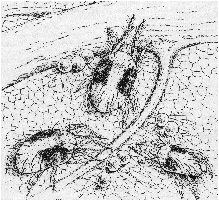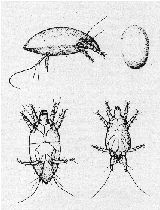Strawberry Mites
Tetranychus urticae and Steneotarsonemus pallidus

Two spotted spider mites. Adults are
approximately 1/50 inch (0.5 mm) long.
Biology
Two spotted Spider Mite, Tetranychus urticae:
Adult two-spotted spider mites are 1/50-inch long and pale greenish to
crimson in color. Females are marked with two dark blotches. Mated adult
females overwinter in the cover of vegetation in fields and along
roadsides and hedgerows. They begin feeding and laying eggs when
temperatures rise in the spring, and several generations develop each
season. Although wingless, they are highly mobile, as they disperse by
"ballooning" in the wind on small silken threads that they secrete while
feeding.
Cyclamen Mite, Steneotarsonemus pallidus: An additional mite pest of strawberries is the cyclamen mite, Steneotarsonemus pallidus. This mite reaches only 1/100-inch in length and is not visible without the aid of a hand lens or magnifying glass.

Cyclamen Mites. These mites
are not visible without a hand
lens or magnifying glass. They
are about 1/100 inch
(0.25 mm) long.
Damage
Spider mites rasp away leaf surfaces to feed on
plant sap, causing mottling, speckling, or bronzing of foliage. Severely
damaged leaves die and drop.
Hot, dry weather favors spider mite outbreaks, and problems occur most often in new fields where spider mites are carried in by winds before predaceous mites have reached the field or in older plantings where insecticides have eliminated predators.
Cyclamen mites are most common as pests of greenhouse plants, but where infested strawberry plants are transplanted in new fields, serious losses can occur. These mites feed on young, unfolding leaves in the crowns of plants and on blossoms, causing leaves, blossoms, and fruits to be distorted.
Control
To scout for spider mites, collect and examine 60
strawberry leaflets per field. The use of a miticide for spider mite
control is justified if 25 percent of the leaflets (15 of 60) are
infested by one or more mites. This threshold corresponds to an average
of 5 mites per leaflet during random sampling.
Where predaceous mites such as Amblyseius fallacis are present, miticide applications usually are unnecessary. These predaceous mites are slightly smaller and more slender than two-spotted spider mites; they also are more mobile on leaf surfaces. Check the most recent edition of the Illinois Commercial Small Fruit and Grape Spray Guide for a listing of registered miticides. Annual renovation of strawberry beds also reduces the potential for outbreaks the following season, as the destruction of leaf tissue by renovation removes the mites' food and habitat.

Amblyseius fallacis, a beneficial predaceous
mite that feeds on spider mites. Adults are
approximately 1/50 inch (0.5 mm) long.
Control of cyclamen mites is best accomplished by examining transplants to ensure that they are free of cyclamen mites. Miticides applied just before bloom can also provide some control.
Although mites occur in many fields, these pests do not damage berries directly and often do not reach high densities. Consequently, controlling them is often unnecessary. Insecticide applications for the control of foliage-feeding pests can and should be based on scouting results, not preventive spray programs.